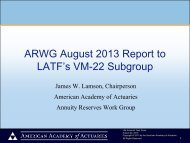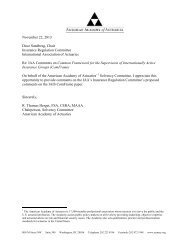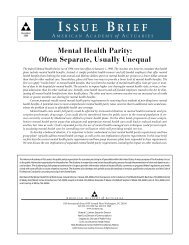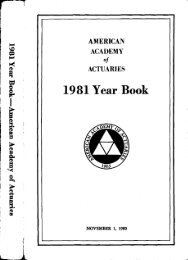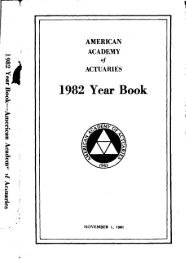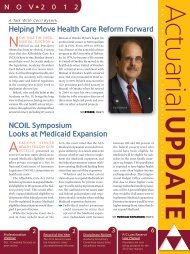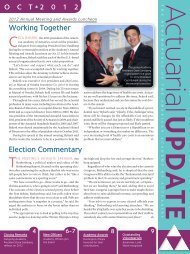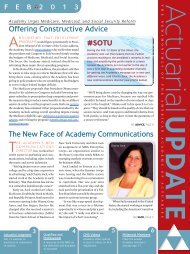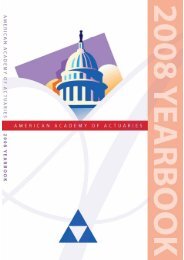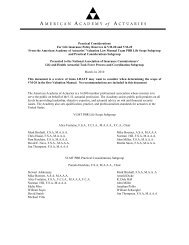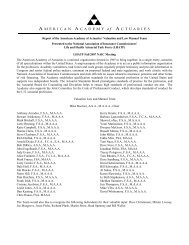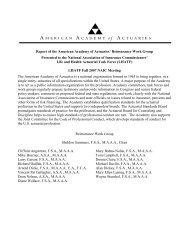Current issues in asbestos litigation - American Academy of Actuaries
Current issues in asbestos litigation - American Academy of Actuaries
Current issues in asbestos litigation - American Academy of Actuaries
You also want an ePaper? Increase the reach of your titles
YUMPU automatically turns print PDFs into web optimized ePapers that Google loves.
A February<br />
2006<br />
Issue Brief<br />
A m e r i c a n Ac a d e my o f Ac t ua r i e s<br />
<strong>Current</strong> Issues <strong>in</strong> Asbestos Litigation<br />
<strong>American</strong> <strong>Academy</strong> <strong>of</strong> <strong>Actuaries</strong> Mass Torts Subcommittee<br />
Asbestos <strong>litigation</strong> is complex and full <strong>of</strong> uncerta<strong>in</strong>ties. The number <strong>of</strong> historical claims (and how much they cost) is difficult to<br />
determ<strong>in</strong>e, mak<strong>in</strong>g predictions <strong>of</strong> future <strong>asbestos</strong> costs even more challeng<strong>in</strong>g. 1<br />
The purpose <strong>of</strong> this document is to provide <strong>in</strong>sight <strong>in</strong>to some <strong>of</strong> the major <strong>issues</strong> that should be considered when evaluat<strong>in</strong>g possible<br />
legislative responses. 2 This document<br />
■ provides a brief overview <strong>of</strong> <strong>asbestos</strong> <strong>litigation</strong>; 3<br />
■ summarizes some <strong>of</strong> the available data measur<strong>in</strong>g the <strong>litigation</strong>; and<br />
■ highlights some <strong>of</strong> the recent changes <strong>in</strong> the <strong>litigation</strong> environment.<br />
Brief Overview<br />
Asbestos was widely used <strong>in</strong> thousands <strong>of</strong> products for decades and is still used <strong>in</strong> some products <strong>in</strong> the United<br />
States today. At least 27.5 million people had significant occupational exposure <strong>in</strong> <strong>in</strong>dustries traditionally associated<br />
with <strong>asbestos</strong> (e.g., shipbuild<strong>in</strong>g, construction) and tens <strong>of</strong> millions more were exposed <strong>in</strong> other <strong>in</strong>dustries. Asbestos<br />
1. Many actuaries are currently <strong>in</strong>volved <strong>in</strong> the estimation <strong>of</strong> such costs.<br />
2. The <strong>American</strong> <strong>Academy</strong> <strong>of</strong> <strong>Actuaries</strong> is the public policy organization for actuaries practic<strong>in</strong>g <strong>in</strong> all specialties with<strong>in</strong> the United States. A major<br />
purpose <strong>of</strong> the <strong>Academy</strong> is to act as the public <strong>in</strong>formation organization for the pr<strong>of</strong>ession. The <strong>Academy</strong> is non-partisan and assists the public<br />
policy process through the presentation <strong>of</strong> clear and objective actuarial analysis. The <strong>Academy</strong> regularly prepares testimony for Congress, provides<br />
<strong>in</strong>formation to federal elected <strong>of</strong>ficials, comments on proposed federal regulations, and works closely with state <strong>of</strong>ficials on <strong>issues</strong> related to <strong>in</strong>surance.<br />
The <strong>Academy</strong> also supports the development and enforcement <strong>of</strong> actuarial practice standards, qualification requirements, and the Code <strong>of</strong><br />
Pr<strong>of</strong>essional Conduct for all actuaries practic<strong>in</strong>g <strong>in</strong> the United States.<br />
3. A more comprehensive discussion can be found <strong>in</strong> the <strong>American</strong> <strong>Academy</strong> <strong>of</strong> <strong>Actuaries</strong> public policy monograph: Overview <strong>of</strong> Asbestos Issues and Trends,<br />
published December 2001.<br />
Members <strong>of</strong> the Mass Torts Subcommittee <strong>in</strong>clude: Jennifer L. Biggs, FCAS, MAAA, Chair; Raja R. Bhagavatula, FCAS, MAAA; Hsiu-Mei Chang, FCAS, MAAA;<br />
Bryan C. Gillespie, FCAS, MAAA; Thomas S. Johnston, FCAS, MAAA; Steven E. Math, FCAS, MAAA; Claus S. Metzner, FSA, FCAS, MAAA; Steven J. Symon, FCAS,<br />
MAAA; Trevar K. Withers, ACAS, MAAA.<br />
A<br />
<strong>American</strong> <strong>Academy</strong> <strong>of</strong> <strong>Actuaries</strong><br />
1100 Seventeenth Street NW Seventh Floor Wash<strong>in</strong>gton, DC 20036<br />
Tel 202 223 8196 Fax 202 872 1948<br />
www.actuary.org<br />
Kev<strong>in</strong> Cron<strong>in</strong>, Executive Director<br />
Noel Card, Director <strong>of</strong> Communications<br />
Craig Hanna, Director <strong>of</strong> Public Policy<br />
Greg Vass Senior Policy Analyst, Casualty<br />
©2006 The <strong>American</strong> <strong>Academy</strong> <strong>of</strong> <strong>Actuaries</strong>. All Rights Reserved.
exposure is conclusively l<strong>in</strong>ked to several medical conditions, rang<strong>in</strong>g from pleural changes with no signs <strong>of</strong><br />
impairment to fatal malignant diseases, <strong>in</strong>clud<strong>in</strong>g lung cancer and <strong>asbestos</strong>’ signature disease, mesothelioma.<br />
Average latency periods vary by disease, rang<strong>in</strong>g from 10 to 50 years. Although occupational exposure to <strong>asbestos</strong><br />
was significantly reduced follow<strong>in</strong>g the establishment <strong>of</strong> Occupational Safety and Health Adm<strong>in</strong>istration<br />
(OSHA) requirements <strong>in</strong> the early 1970s, <strong>asbestos</strong> diseases are expected to manifest at least through 2050<br />
<strong>in</strong> the United States, and longer <strong>in</strong> several other countries where high exposure levels cont<strong>in</strong>ued longer.<br />
An <strong>in</strong>dividual victim’s disease is typically attributed to exposure to multiple <strong>asbestos</strong> products over decades<br />
<strong>of</strong> use, and it is virtually impossible to isolate a specific exposure caus<strong>in</strong>g the disease. As a result, a s<strong>in</strong>gle<br />
claimant typically files suit aga<strong>in</strong>st 60 or more defendants. The majority <strong>of</strong> claims are filed <strong>in</strong> state rather than<br />
federal courts and the mix <strong>of</strong> claims by state has varied dramatically over time.<br />
In spite <strong>of</strong> the magnitude <strong>of</strong> <strong>asbestos</strong> <strong>litigation</strong>, there is not a s<strong>in</strong>gle registry for <strong>asbestos</strong> disease <strong>in</strong>cidence<br />
and claim fil<strong>in</strong>g <strong>in</strong>formation. This lack <strong>of</strong> <strong>in</strong>formation makes analyses <strong>of</strong> future claim emergence and costs<br />
more challeng<strong>in</strong>g and can lead to divergent views.<br />
While the Centers for Disease Control and Prevention (CDC) now publishes statistics regard<strong>in</strong>g <strong>asbestos</strong>is<br />
and mesothelioma deaths, 4 this <strong>in</strong>formation is <strong>in</strong>complete before 1999 and it does not consider non-fatal<br />
conditions.<br />
Thousands <strong>of</strong> companies have been named as defendants <strong>in</strong> <strong>asbestos</strong> <strong>litigation</strong>. Some were major producers,<br />
while others had more peripheral <strong>in</strong>volvement. 5 Publicly traded companies are required by the U.S.<br />
Securities and Exchange Commission (SEC) to disclose <strong>in</strong>formation regard<strong>in</strong>g <strong>asbestos</strong> <strong>litigation</strong> only to the<br />
extent that it is material; for many, however, the potential liabilities are fully <strong>in</strong>sured or <strong>in</strong>significant relative<br />
to their net worth. As a result, the level <strong>of</strong> detail <strong>in</strong>cluded <strong>in</strong> the corporate defendant disclosures varies markedly<br />
and is complicated by a labyr<strong>in</strong>th <strong>of</strong> changes <strong>in</strong> corporate names and legal structures (<strong>in</strong>clud<strong>in</strong>g mergers,<br />
acquisitions, and divestitures). Therefore, many use data from the Manville Personal Injury Trust to gauge<br />
<strong>in</strong>dustry claim fil<strong>in</strong>g activity, s<strong>in</strong>ce it <strong>in</strong>cludes <strong>in</strong>formation regard<strong>in</strong>g the number <strong>of</strong> claims by disease.<br />
The most uniform source <strong>of</strong> <strong>asbestos</strong> <strong>in</strong>formation is provided by U.S. property / casualty <strong>in</strong>surers regard<strong>in</strong>g<br />
their aggregate calendar-year <strong>asbestos</strong> payments and the liability estimates they establish to pay for<br />
pend<strong>in</strong>g and future claims (i.e., reserves). However, <strong>in</strong>surers’ statutory annual statement disclosures do not<br />
provide details, such as the number <strong>of</strong> claims, diseases, or defendants underly<strong>in</strong>g the payments and reserves.<br />
Similar disclosures are not required for non-U.S. <strong>in</strong>surers or for non-U.S. affiliates <strong>of</strong> U.S. <strong>in</strong>surers.<br />
One <strong>of</strong> the most comprehensive studies <strong>of</strong> <strong>asbestos</strong> <strong>litigation</strong> is the RAND Corporation’s May 2005 report. 6<br />
RAND concludes that at least 730,000 <strong>asbestos</strong> claimants filed lawsuits through 2002 aga<strong>in</strong>st more than 8,400<br />
defendant companies. Further, the RAND report states that the number <strong>of</strong> claims filed annually <strong>in</strong>creased<br />
sharply beg<strong>in</strong>n<strong>in</strong>g <strong>in</strong> the mid-to-late 1990s. Claimants with nonmalignant <strong>in</strong>juries account for most <strong>of</strong> the<br />
growth, and some evidence suggests that most nonmalignant claimants are currently unimpaired. The volume<br />
<strong>of</strong> claims has heightened concerns regard<strong>in</strong>g the depletion <strong>of</strong> funds available to pay future claimants and<br />
the burdens placed on the courts. (The Congressional Budget Office estimates that there are 322,000 pend<strong>in</strong>g<br />
claims.) Accord<strong>in</strong>g to the RAND study, at least half <strong>of</strong> the $70 billion <strong>of</strong> <strong>asbestos</strong> claims paid by defendants<br />
and their <strong>in</strong>surers were related to nonmalignant conditions. The RAND study does not <strong>in</strong>clude <strong>in</strong>formation<br />
beyond 2002and there have been notable changes s<strong>in</strong>ce that time, <strong>in</strong>clud<strong>in</strong>g:<br />
4. Attachment 1 shows mesothelioma, <strong>asbestos</strong>is, and silicosis deaths by year.<br />
5. Peripheral defendants <strong>in</strong>clude companies that manufactured products where <strong>asbestos</strong> was encapsulated, distributed products conta<strong>in</strong><strong>in</strong>g <strong>asbestos</strong>,<br />
or owned premises conta<strong>in</strong><strong>in</strong>g <strong>asbestos</strong>.<br />
6. RAND Institute for Civil Justice, “Asbestos Litigation” by Stephen Carroll, Deborah Hensler, Jennifer Gross, Elizabeth M. Sloss, Matthias Schonlau,<br />
Allan Abrahamse, J. Scott Ashwood. 2005. http://www.rand.org/publications/<br />
2 ISSUE BRIEF FEBRUARY 2006
■ more efforts to direct scarce resources to the sickest claimants, <strong>in</strong>clud<strong>in</strong>g changes to the Manville Trust<br />
Distribution Process (TDP) and state reforms impos<strong>in</strong>g medical criteria to br<strong>in</strong>g a claim;<br />
■ a decrease <strong>in</strong> claim fil<strong>in</strong>gs dur<strong>in</strong>g 2004 - 2005 for less severe medical conditions;<br />
■ additional bankruptcies, but at a lower annual rate as pre-packaged bankruptcies are challenged and other<br />
potential solutions are pursued;<br />
■ cont<strong>in</strong>ued federal and state reform efforts; and<br />
■ heightened scrut<strong>in</strong>y <strong>of</strong> potentially fraudulent claims.<br />
Available Data Sources<br />
Manville Information<br />
The Johns-Manville Corporation, the largest manufacturer <strong>of</strong> <strong>asbestos</strong>-conta<strong>in</strong><strong>in</strong>g products and the largest<br />
supplier <strong>of</strong> <strong>asbestos</strong> <strong>in</strong> the U.S. filed for bankruptcy <strong>in</strong> August 1982 as a result <strong>of</strong> <strong>asbestos</strong> <strong>litigation</strong>. The<br />
Manville Personal Injury Trust (Manville Trust), which was formed to distribute limited assets among current<br />
and future <strong>asbestos</strong> claimants who were exposed to Manville products, was approved and began pay<strong>in</strong>g<br />
claims <strong>in</strong> 1988.<br />
Historically, <strong>in</strong>formation regard<strong>in</strong>g claims filed aga<strong>in</strong>st the Manville Trust as well as conclusions from expert<br />
reports project<strong>in</strong>g future claims aga<strong>in</strong>st the Manville Trust have been publicly available. Manville Trust<br />
claims experience through Dec. 31, 2005 is summarized <strong>in</strong> Attachment 2.<br />
At first glance, the Manville Trust data shows some curious aberrations. The total number <strong>of</strong> claims spikes<br />
to more than 100,000 <strong>in</strong> 2003, followed by significantly lower levels <strong>in</strong> 2004 - 2005. When <strong>in</strong>terpret<strong>in</strong>g the<br />
Manville Trust data it is important to recognize changes <strong>in</strong> the TDP and other factors that have <strong>in</strong>fluenced<br />
claim fil<strong>in</strong>g rates over time. Background <strong>in</strong>formation regard<strong>in</strong>g the Manville Trust summarized <strong>in</strong> Attachment<br />
2, coupled with a more ref<strong>in</strong>ed review <strong>of</strong> the claim fil<strong>in</strong>g data, provides context for these abrupt changes.<br />
When review<strong>in</strong>g the Manville Trust claim fil<strong>in</strong>g data by disease type, it is apparent that mesothelioma<br />
claims have <strong>in</strong>creased steadily s<strong>in</strong>ce 1998. The spike <strong>in</strong> 2003 is attributable to the change <strong>in</strong> the TDP effective<br />
dur<strong>in</strong>g that year. However, even sett<strong>in</strong>g 2003 aside, there is clearly an <strong>in</strong>creas<strong>in</strong>g trend. Many believe that the<br />
<strong>in</strong>crease <strong>in</strong> mesothelioma claims reflects greater medical awareness and diagnoses <strong>of</strong> mesothelioma cases as<br />
well as an <strong>in</strong>crease <strong>in</strong> claimants’ propensity to sue, rather than an <strong>in</strong>crease <strong>in</strong> disease <strong>in</strong>cidence. Even adjust<strong>in</strong>g<br />
for the TDP-related spike <strong>in</strong> 2003, it does not appear that the number <strong>of</strong> mesothelioma claims has begun to<br />
decl<strong>in</strong>e, as they eventually will due to reductions <strong>in</strong> significant occupational exposure <strong>in</strong> the 1970s. Similarly,<br />
<strong>asbestos</strong>-related lung and other cancer claims generally <strong>in</strong>creased from 1998 to 2003.<br />
Historical nonmalignant claim levels have shown more variation over time. Medical criteria and occupational<br />
exposure thresholds as well as identification <strong>of</strong> claimants who currently show no signs <strong>of</strong> impairment<br />
have <strong>in</strong>fluenced claim fil<strong>in</strong>g activity.<br />
The Manville Trust obta<strong>in</strong>s projections <strong>of</strong> its future claims experience periodically; the most recent projections<br />
<strong>in</strong>dicate that 1.2 million to 2.1 million claims will ultimately be filed.<br />
ISSUE BRIEF FEBRUARY 2006 3
Projections <strong>of</strong> Future Asbestos Claims Aga<strong>in</strong>st the Manville Trust – U.S. Exposure (thousands)<br />
Disease Type Filed Through 2004 Projected 2005+ Estimated Ultimate Claims<br />
Malignant 79 107 (range: 86-128) 7 186 (range: 165-207)<br />
Nonmalignant 568 743 (range: 487-1,276) 8 1,311 (range: 1,055-1,844)<br />
TOTAL 647 9 850 (range: 573-1,404) 1,497 (range: 1,220-2,051)<br />
Future mesothelioma claims are considered estimable based on epidemiological factors such as the population<br />
exposed, the tim<strong>in</strong>g <strong>of</strong> the exposure, and disease latency. Future <strong>asbestos</strong>-related cancer claims are<br />
more difficult to predict s<strong>in</strong>ce there are several other causes <strong>of</strong> cancer, notably tobacco use.<br />
Asbestosis is dose-dependent, so serious <strong>asbestos</strong>is claims might decl<strong>in</strong>e <strong>in</strong> the future, reflect<strong>in</strong>g lower occupational<br />
exposure. While some nonmalignant claims are life threaten<strong>in</strong>g (e.g., severe <strong>asbestos</strong>is), most claimants with nonmalignant<br />
conditions do not exhibit signs <strong>of</strong> impairment. Epidemiological considerations are less useful for predict<strong>in</strong>g future<br />
nonmalignant claims than malignant claims. Nonmalignant claims are generally <strong>in</strong>fluenced more by factors affect<strong>in</strong>g<br />
litigiousness, such as recruitment efforts through media advertis<strong>in</strong>g and mass screen<strong>in</strong>gs.<br />
The claims experience <strong>of</strong> the Manville Trust is substantial, and most <strong>asbestos</strong> claimants have sought compensation<br />
from the Manville Trust. However, the tim<strong>in</strong>g <strong>of</strong> claims aga<strong>in</strong>st the Manville Trust <strong>of</strong>ten differs<br />
from that <strong>of</strong> claims filed aga<strong>in</strong>st solvent defendants <strong>in</strong> federal or state courts; Manville claims are <strong>of</strong>ten delayed<br />
until the court cases are resolved <strong>in</strong> order to avoid an <strong>of</strong>fset to court awards. In the future, the medical<br />
and exposure criteria specified <strong>in</strong> Manville’s 2002 TDP might cause more <strong>of</strong> a divergence between Manville<br />
Trust and court-based claim experience, s<strong>in</strong>ce other forums might not have similar criteria for payment. 10<br />
Like the Johns-Manville Corporation, many <strong>of</strong> the other major <strong>asbestos</strong> producers have declared bankruptcy,<br />
affect<strong>in</strong>g their ability to pay the full value <strong>of</strong> claims made aga<strong>in</strong>st them and delay<strong>in</strong>g payments until<br />
bankruptcy plans are approved and operational. Although the Scheduled Value <strong>of</strong> nonmalignant claims was<br />
reduced under the Manville Trust’s 2002 TDP, and the recent fil<strong>in</strong>g <strong>of</strong> nonmalignant claims dropped dramatically,<br />
the <strong>in</strong>centive to pursue these claims might be restored once several <strong>of</strong> the more recent bankruptcy plans<br />
are confirmed. As long as payments to unimpaired claimants are not elim<strong>in</strong>ated, even if they are small, 11 it<br />
might be worthwhile for claimants to pursue these small payments across multiple trusts, especially if the<br />
trusts establish efficient on-l<strong>in</strong>e mechanisms to process the claims.<br />
Corporate Defendant Bankruptcies<br />
There are vary<strong>in</strong>g lists <strong>of</strong> companies that have sought bankruptcy protection as a result <strong>of</strong> <strong>asbestos</strong> <strong>litigation</strong>.<br />
The <strong>Academy</strong> list currently conta<strong>in</strong>s 78 companies and is shown <strong>in</strong> Attachment 3. While the rate <strong>of</strong> bankruptcies<br />
<strong>in</strong>creased significantly dur<strong>in</strong>g 2000-2002, it has slowed <strong>in</strong> the past few years, as “pre-packaged” bankruptcies 12 have<br />
7. The malignant count reduces to 79,000 (range: 66,000 – 107,000) exclud<strong>in</strong>g Manville Level 6 lung cancer claims without underly<strong>in</strong>g <strong>asbestos</strong><br />
disease that would not be compensated under S.852.<br />
8. http://www.mantrust.org/FILINGS/Q2_05/000457B4.pdf and “Asbestos: The Times They are A-Chang<strong>in</strong>’ ” a Till<strong>in</strong>ghast and Claims Resolution<br />
Management Corporation Sem<strong>in</strong>ar, 9/29/2005. Given changes <strong>in</strong> the legal process, <strong>in</strong>clud<strong>in</strong>g state reforms and the recent heightened scrut<strong>in</strong>y <strong>of</strong><br />
mass screen<strong>in</strong>g practices, care must be taken when us<strong>in</strong>g or compar<strong>in</strong>g various projections <strong>of</strong> future nonmalignant claims.<br />
9. Excludes 14,000 denied/unknown claims.<br />
10. For example, only a few state courts have enacted medical criteria or require occupational exposure.<br />
11. The Manville Trust currently pays $600 to those claimants with the lowest levels <strong>of</strong> impairment and those not meet<strong>in</strong>g significant occupational<br />
exposure requirements. Level 1 cash discount payments are $600 and the Level 2 Scheduled Value <strong>of</strong> $12,000 multiplied by the current 5% pro<br />
rata share also equals $600.<br />
12. Several “pre-packaged” bankruptcies have been filed <strong>in</strong> the past few years, with an objective <strong>of</strong> reduc<strong>in</strong>g the time until the plan is confirmed<br />
by negotiat<strong>in</strong>g the plan with claimants before fil<strong>in</strong>g and schedul<strong>in</strong>g a comb<strong>in</strong>ed hear<strong>in</strong>g for disclosure and confirmation <strong>of</strong> the plan with<strong>in</strong> a few<br />
months <strong>of</strong> fil<strong>in</strong>g.<br />
4 ISSUE BRIEF FEBRUARY 2006
een challenged and several companies have awaited the outcome <strong>of</strong> federal and state legislative efforts.<br />
As numerous corporate defendants have entered bankruptcy, there has been upward pressure on claim<br />
settlements demanded from rema<strong>in</strong><strong>in</strong>g solvent defendants.<br />
Experience <strong>of</strong> U.S. Insurers/Re<strong>in</strong>surers<br />
Based on data filed with state <strong>in</strong>surance regulators by U.S. property / casualty <strong>in</strong>surers, the <strong>in</strong>surance<br />
<strong>in</strong>dustry has paid approximately $31.8 billion <strong>in</strong> <strong>asbestos</strong> loss and expense through Dec. 31, 2004, net <strong>of</strong> re<strong>in</strong>surance.<br />
13 Additionally, these U.S. <strong>in</strong>surers and re<strong>in</strong>surers held $22.7 billion <strong>in</strong> net reserves to pay pend<strong>in</strong>g<br />
and anticipated future claims over the next several decades.<br />
Asbestos liabilities recognized by the U.S. property / casualty <strong>in</strong>surance <strong>in</strong>dustry are summarized <strong>in</strong> the<br />
table below. The difficulties associated with estimat<strong>in</strong>g these liabilities are demonstrated by the significant<br />
<strong>in</strong>creases <strong>in</strong> <strong>in</strong>curred 14 loss and expense over the past few years.<br />
U.S. Property / Casualty Asbestos Loss and Expense Net <strong>of</strong> Re<strong>in</strong>surance ($billions)<br />
Incremental Net Cumulative Net Year-End Net Cumulative Change <strong>in</strong><br />
Year<br />
Paid<br />
Paid<br />
Paid<br />
Incurred Incurred<br />
2000 1.39 22.20 10.53 32.73 1.41<br />
2001 1.54 23.74 13.02 36.76 4.03<br />
2002 2.08 25.82 18.96 44.78 8.01<br />
2003 2.66 28.48 22.33 50.81 6.04<br />
2004 3.29 31.77 22.68 54.45 3.64<br />
Expenses<br />
The <strong>asbestos</strong> <strong>litigation</strong> system has been an <strong>in</strong>efficient mechanism for provid<strong>in</strong>g compensation to victims<br />
<strong>of</strong> <strong>asbestos</strong> disease. Accord<strong>in</strong>g to the RAND study, defense transaction costs consumed approximately 30<br />
percent <strong>of</strong> total payments through 2002. RAND estimates that rema<strong>in</strong><strong>in</strong>g payments (i.e., gross compensation<br />
to claimants) are split, 29 percent to cover pla<strong>in</strong>tiff attorney fees and other legal costs, and only 41 percent <strong>of</strong><br />
total spend<strong>in</strong>g reached the claimants as net compensation.<br />
Defense costs could <strong>in</strong>crease <strong>in</strong> the future, at least temporarily, s<strong>in</strong>ce:<br />
■ more defendants are now <strong>in</strong>volved <strong>in</strong> the <strong>litigation</strong> and defense is no longer rout<strong>in</strong>ely handled on a jo<strong>in</strong>t<br />
basis;<br />
■ many defendants have abandoned settlement strategies;<br />
■ newer defendants are <strong>in</strong>curr<strong>in</strong>g significant discovery costs as they work to understand their exposure and<br />
potential defenses; and<br />
■ coverage disputes between defendants and their <strong>in</strong>surers, as well as between <strong>in</strong>surers and their re<strong>in</strong>surers,<br />
might <strong>in</strong>crease (e.g., pro<strong>of</strong> <strong>of</strong> coverage for newer defendants, operations claims, etc.).<br />
13. The National Association <strong>of</strong> Insurance Commissioners (NAIC) requires that U.S. property casualty <strong>in</strong>surers disclose <strong>in</strong>formation regard<strong>in</strong>g<br />
<strong>asbestos</strong> and environmental payments and liability reserves <strong>in</strong> Note 33 <strong>of</strong> their statutory annual statements. Composite <strong>in</strong>dustry data as <strong>of</strong> Dec.<br />
31, 2005 will not become available until mid-2006.<br />
14. Annual <strong>in</strong>curred amounts equal the change <strong>in</strong> paid loss and expense plus the change <strong>in</strong> estimated liability reserves for future payments on<br />
pend<strong>in</strong>g and unreported claims.<br />
ISSUE BRIEF FEBRUARY 2006 5
Recent and Proposed Changes <strong>in</strong> the Litigation Environment<br />
Proposed Federal Legislation – S.852<br />
The U.S. Senate has considered various solutions to the ongo<strong>in</strong>g <strong>asbestos</strong> <strong>litigation</strong> crisis over the past few<br />
years. Of several bills <strong>in</strong>troduced, the trust fund approach has been pursued most vigorously. The Senate<br />
Judiciary Committee approved the latest version <strong>of</strong> the Fairness <strong>in</strong> Asbestos Injury Resolution, or FAIR Act<br />
(S.852) on May 26, 2005; and as <strong>of</strong> press time, was hopeful <strong>of</strong> br<strong>in</strong>g<strong>in</strong>g the legislation before the full Senate <strong>in</strong><br />
early 2006. This legislation would establish a no-fault trust from which claimants meet<strong>in</strong>g <strong>asbestos</strong> exposure<br />
and medical criteria would be compensated for their <strong>in</strong>juries. The proposed trust would be funded with $140<br />
billion <strong>of</strong> contributions from corporate defendants, <strong>in</strong>surers, and exist<strong>in</strong>g bankruptcy trusts. If the fund<strong>in</strong>g<br />
ultimately proves to be <strong>in</strong>sufficient, claims could return to the courts.<br />
The proposed legislation has been subject to considerable open debate, revolv<strong>in</strong>g around several questions,<br />
such as:<br />
■ How many claims <strong>of</strong> various disease types will be filed? Mesothelioma and severe <strong>asbestos</strong>is cases are<br />
considered predictable based on epidemiological factors; however, there are differ<strong>in</strong>g projections <strong>of</strong> future<br />
claims for cancers and nonmalignant pleural conditions.<br />
■ Will the medical criteria appropriately identify victims <strong>of</strong> <strong>asbestos</strong> disease?<br />
■ Are the proposed awards appropriate?<br />
■ Is the proposed fund<strong>in</strong>g adequate?<br />
■ Will the allocation <strong>of</strong> fund<strong>in</strong>g from the various classes <strong>of</strong> contributors be viable and fair?<br />
■ Will the fund be operated efficiently?<br />
■ Will the new statute withstand constitutional challenges?<br />
■ Will corporate defendants and their <strong>in</strong>surers / re<strong>in</strong>surers support legislation that does not provide f<strong>in</strong>ality? 15<br />
State Reforms<br />
As potential federal reform has been debated, several states have implemented judicial and legislative reforms<br />
affect<strong>in</strong>g the tort claim process. These reforms focus the courts’ resources on the claims <strong>of</strong> the most<br />
seriously <strong>in</strong>jured.<br />
Judicial reforms such as <strong>in</strong>active dockets (which preserve the right to sue for those who do not currently<br />
meet the specific medical criteria) 16 have been established <strong>in</strong> several jurisdictions, <strong>in</strong>clud<strong>in</strong>g:<br />
■ Ill<strong>in</strong>ois: Chicago, St. Clair County, Madison County, and Cook County<br />
■ Maryland: Baltimore<br />
■ Massachusetts: Boston<br />
15. Insurers / re<strong>in</strong>surers have expressed concern that they could be required to make significant front-ended contributions to the trust (comparable<br />
to their total current liability reserves), yet additional payments could be required from them if it is determ<strong>in</strong>ed that the fund is <strong>in</strong>sufficient<br />
to pay its obligations (<strong>in</strong>clud<strong>in</strong>g potential borrow<strong>in</strong>g costs) and claims revert to the court system.<br />
16. Some <strong>in</strong>dividuals on <strong>in</strong>active dockets might eventually develop qualify<strong>in</strong>g medical conditions. Future <strong>in</strong>cidence <strong>of</strong> mesothelioma is <strong>in</strong>cluded<br />
with<strong>in</strong> future disease projections based on the tim<strong>in</strong>g <strong>of</strong> exposure and disease latency.<br />
6 ISSUE BRIEF FEBRUARY 2006
■ M<strong>in</strong>nesota<br />
■ New York: New York City and Syracuse<br />
■ Virg<strong>in</strong>ia: Portsmouth<br />
■ Wash<strong>in</strong>gton: Seattle and K<strong>in</strong>g County.<br />
Additionally, Florida, Georgia, Ohio, and Texas have passed legislation that requires <strong>asbestos</strong> claimants to<br />
satisfy medical criteria <strong>in</strong> order to br<strong>in</strong>g a claim.<br />
As a result <strong>of</strong> these reforms, <strong>asbestos</strong> <strong>litigation</strong> <strong>in</strong> these states will likely change to a more <strong>in</strong>dividualized<br />
process <strong>in</strong>volv<strong>in</strong>g s<strong>in</strong>gle-pla<strong>in</strong>tiff claims by the most severely <strong>in</strong>jured. The more <strong>in</strong>dividualized process is<br />
likely to <strong>in</strong>crease expenses for claimants and defendants as well as the average compensation for malignant<br />
claims. Additionally, the limited number <strong>of</strong> mesothelioma claims might cause more pla<strong>in</strong>tiff attorney focus<br />
on other cancer claims.<br />
Some jurisdictions, notably Mississippi, Texas, and West Virg<strong>in</strong>ia, have revised laws relat<strong>in</strong>g to case consolidation<br />
and forum, tighten<strong>in</strong>g restrictions regard<strong>in</strong>g the connection between a pla<strong>in</strong>tiff and the venue <strong>of</strong><br />
the case. Other state reforms relate to <strong>in</strong>nocent sellers, successor liability, and caps on non-economic and<br />
punitive damages.<br />
The majority <strong>of</strong> pend<strong>in</strong>g <strong>asbestos</strong> <strong>litigation</strong> is <strong>in</strong> states that have now enacted some type <strong>of</strong> legislative or<br />
judicial reform, but a key question is whether new forums will emerge. Historically, the distribution <strong>of</strong> claims<br />
by state has changed dramatically, as shown <strong>in</strong> the graph <strong>in</strong> Attachment 4.<br />
Scrut<strong>in</strong>y <strong>of</strong> Potentially Fraudulent Claims<br />
Pla<strong>in</strong>tiff attorneys <strong>in</strong> <strong>asbestos</strong> and silica lawsuits have tended to comb<strong>in</strong>e large numbers <strong>of</strong> claimants <strong>in</strong> a<br />
s<strong>in</strong>gle lawsuit, mak<strong>in</strong>g it difficult and costly for defendants to assess the validity <strong>of</strong> each claimant’s case. Many<br />
<strong>of</strong> these claimants have been diagnosed through mass screen<strong>in</strong>g programs. Recent events have cast considerable<br />
doubt on these diagnoses.<br />
A 2004 Johns Hopk<strong>in</strong>s Medical Institutions study 17 published <strong>in</strong> Academic Radiology called the diagnoses<br />
<strong>of</strong> some physicians <strong>in</strong>to question. In the study, <strong>in</strong>dependent radiologists reviewed approximately 500 chest xrays<br />
that had previously been entered <strong>in</strong>to evidence <strong>in</strong> <strong>asbestos</strong> lawsuits and exam<strong>in</strong>ed by physicians reta<strong>in</strong>ed<br />
by pla<strong>in</strong>tiff attorneys. The <strong>in</strong>dependent radiologists found abnormalities <strong>in</strong> 4.5 percent <strong>of</strong> the films, as compared<br />
to the orig<strong>in</strong>al read<strong>in</strong>gs where 96 percent <strong>of</strong> the films supposedly showed evidence <strong>of</strong> <strong>asbestos</strong> disease.<br />
Physician depositions <strong>in</strong> the Silica Multi-District Litigation (MDL) hear<strong>in</strong>gs 18 held by U.S. District Judge<br />
Janis Graham Jack <strong>in</strong> Corpus Christi, Texas <strong>in</strong> February 2005, cast considerable doubt on the silicosis diagnoses<br />
for 10,000 claimants. Although it is highly unlikely for someone to have both silicosis and <strong>asbestos</strong>is, it<br />
was found that some doctors had diagnosed <strong>in</strong>dividual claimants with <strong>asbestos</strong>is at one time and then silicosis<br />
at a later date. More than 50 percent <strong>of</strong> the silica claimants had previously filed <strong>asbestos</strong> claims with the<br />
Manville Trust. Judge Jack concluded, “These diagnoses were driven by neither health nor justice: they were<br />
manufactured for money.” While Judge Jack’s decision is not b<strong>in</strong>d<strong>in</strong>g on the state judges to whom the silica<br />
17. “Comparison <strong>of</strong> ‘B’ Readers’ Interpretations <strong>of</strong> Chest Radiographs for Asbestos Related Changes” by Joseph N. Gitl<strong>in</strong>, DPH, Leroy L. Cook, BA,<br />
Otha W. L<strong>in</strong>ton, MSJ, Elizabeth Garrett-Mayer, PhD Acad Radiol 2004; 11:843-856<br />
18. In re Silica Products Liability Litigation, MDL-1553, Southern District <strong>of</strong> Texas<br />
19. http://www.celotextrust.com/news_details.asp?nid=22; Eagle-Picher Personal Injury Settlement Trust memo to Claimants’ Counsel,<br />
10/19/2005; and Claims Resolution Management Corporation memo Re: Suspension <strong>of</strong> Acceptance <strong>of</strong> Medical Reports, 9/12/2005.<br />
20. Jonathan D. Glater, Civil Suits Over Silica <strong>in</strong> Texas Become a Crim<strong>in</strong>al Matter <strong>in</strong> New York, NY Times, 5/18/2005, B1.<br />
ISSUE BRIEF FEBRUARY 2006 7
MDL cases are returned, many believe that her decision is likely to lead to higher medical evidentiary standards<br />
for silica as well as <strong>asbestos</strong> claims. For example, the Celotex, Eagle Picher, and Manville bankruptcy<br />
trusts recently suspended acceptance <strong>of</strong> claims from certa<strong>in</strong> medical screen<strong>in</strong>g companies and/or physicians,<br />
cit<strong>in</strong>g questions regard<strong>in</strong>g their reliability. 19 Additionally, a federal grand jury <strong>in</strong> New York is <strong>in</strong>vestigat<strong>in</strong>g the<br />
situation. 20<br />
The impact <strong>of</strong> this heightened scrut<strong>in</strong>y <strong>in</strong> conjunction with stricter medical criteria adopted by some states<br />
<strong>in</strong> the form <strong>of</strong> <strong>in</strong>active dockets or legislation might lead to fewer mass settlements <strong>of</strong> pend<strong>in</strong>g claim <strong>in</strong>ventories<br />
and will likely affect whether and how mass screen<strong>in</strong>g activities are conducted <strong>in</strong> the future.<br />
Conclusions<br />
There have been numerous cries for reform to the <strong>asbestos</strong> <strong>litigation</strong> process, <strong>in</strong>clud<strong>in</strong>g pleas from the<br />
U.S. Supreme Court for a federal legislative solution, 21 and some state reforms have occurred. However, development<br />
and evaluation <strong>of</strong> the proposed federal reform is challeng<strong>in</strong>g. Those <strong>in</strong>volved <strong>in</strong> draft<strong>in</strong>g potential<br />
legislation <strong>in</strong> the form <strong>of</strong> a trust fund have found that there are many oppos<strong>in</strong>g views to balance; there is “no<br />
easy fix” and they need to be aware <strong>of</strong> potential un<strong>in</strong>tended consequences. 22<br />
Analytic evaluations <strong>of</strong> the economic costs associated with various proposals are not certa<strong>in</strong>, because<br />
sources <strong>of</strong> <strong>in</strong>formation regard<strong>in</strong>g <strong>asbestos</strong> claims are limited and the time horizon for the projections spans<br />
50 years. Apparent trends <strong>in</strong> the available data are <strong>of</strong>ten affected simultaneously by several factors <strong>in</strong> this<br />
complex <strong>litigation</strong> environment and might or might not be predictive <strong>of</strong> the future. Simple extrapolation<br />
<strong>of</strong> historical and recent experience without knowledge and appropriate <strong>in</strong>terpretation <strong>of</strong> the underly<strong>in</strong>g <strong>in</strong>fluential<br />
factors could result <strong>in</strong> mislead<strong>in</strong>g conclusions. The available <strong>in</strong>formation requires <strong>in</strong>formed and<br />
objective analysis. Such analysis will not lead to certa<strong>in</strong>ty regard<strong>in</strong>g predictions <strong>of</strong> future events; however,<br />
mean<strong>in</strong>gful <strong>in</strong>formation can be provided regard<strong>in</strong>g potential outcomes to <strong>in</strong>form the public policy debate.<br />
21. In Amchem Products, Inc. et al. v. W<strong>in</strong>dsor et al., 96 Sup. Ct. 270 (1997) the court observed that “the argument is sensibly made that a nationwide<br />
adm<strong>in</strong>istrative claims process<strong>in</strong>g regime would provide the most secure, fair, and efficient means <strong>of</strong> compensat<strong>in</strong>g victims <strong>of</strong> <strong>asbestos</strong> exposure.<br />
Congress, however, has not adopted such a solution.” and <strong>in</strong> Ortiz v. Fibreboard, 97 Sup. Ct. 1704 (1999) the Supreme Court said <strong>asbestos</strong><br />
<strong>litigation</strong> is an “elephant<strong>in</strong>e mass … that calls for national legislation.”<br />
22. For example, the Workers’ Compensation Subcommittee <strong>of</strong> the <strong>American</strong> <strong>Academy</strong> <strong>of</strong> <strong>Actuaries</strong> provided a letter to Senators Specter and<br />
Leahy dated September 8, 2005 regard<strong>in</strong>g the potential for significant <strong>in</strong>creases <strong>in</strong> workers’ compensation claims relat<strong>in</strong>g to <strong>asbestos</strong> disease.<br />
Section 135 <strong>of</strong> S.852 would ext<strong>in</strong>guish subrogation rights, likely result<strong>in</strong>g <strong>in</strong> more <strong>asbestos</strong> workers compensation claims due to new<br />
f<strong>in</strong>ancial <strong>in</strong>centives (i.e., the potential for double recovery).<br />
8 ISSUE BRIEF FEBRUARY 2006
Summary <strong>of</strong> Attachments<br />
Attachment 1 - CDC Deaths - Mesothelioma, Asbestosis, and Silicosis<br />
Attachment 2 - Claims Filed Aga<strong>in</strong>st the Manville Personal Injury Trust<br />
Attachment 3 - Sheet 1, Asbestos Defendants Declar<strong>in</strong>g Bankruptcy<br />
Attachment 3 - Sheet 2, Number <strong>of</strong> Asbestos Related Bankruptcies per Year<br />
Attachment 4 - Percentage <strong>of</strong> Claims Filed <strong>in</strong> State Courts by State<br />
ISSUE BRIEF FEBRUARY 2006 9
10 ISSUE BRIEF FEBRUARY 2006<br />
Attachment 1<br />
CDC Deaths 23 – Mesothelioma 24 , Asbestosis, and Silicosis<br />
23. ftp:///ftp.cdc.gov/pub/Health_Statistics/NCHS/Publications/Health_US/hus04tables/<br />
24. Prior to the <strong>in</strong>troduction <strong>of</strong> ICD-10 codes <strong>in</strong> 1999, there was no disease code for malignant mesothelioma; a crude estimate was<br />
based on the sum <strong>of</strong> ICD-9 categories malignant neoplasm <strong>of</strong> peritoneum and malignant neoplasm <strong>of</strong> pleura.
Attachment 2<br />
Claims Filed Aga<strong>in</strong>st the Manville Personal Injury Trust 25<br />
25. Although Johns-Manville sought bankruptcy protection <strong>in</strong> 1982, the Manville Trust did not become operational until 1988. The<br />
claim fil<strong>in</strong>g statistics show a backlog <strong>of</strong> claims filed <strong>in</strong> 1989. Claim fil<strong>in</strong>g rates quickly exceeded <strong>in</strong>itial expectations, and payments<br />
were essentially stayed from 1991 – 1994. In 1995 payments resumed at 10% <strong>of</strong> scheduled values. In 2001 the pro-rata payment was<br />
reduced to 5% and a new TDP was <strong>in</strong>troduced <strong>in</strong> 2002. The high level <strong>of</strong> fil<strong>in</strong>gs <strong>in</strong> 2003 was <strong>in</strong>fluenced by a deadl<strong>in</strong>e to file claims<br />
under the criteria from the 1995 TDP. The revised 2002 TDP applies more str<strong>in</strong>gent medical and exposure criteria, shift<strong>in</strong>g compensation<br />
toward claimants with more severe <strong>in</strong>juries.<br />
ISSUE BRIEF FEBRUARY 2006 11
Year <strong>of</strong><br />
Company Bankruptcy<br />
1. A.P. Green 2002<br />
2. API Inc. 2005<br />
3. A-Best 2002<br />
4. *AC&S 2002<br />
5. Amatex Corporation 1982<br />
6. <strong>American</strong> Shipbuild<strong>in</strong>g 1993<br />
7. Armstrong World Industries 2 2000<br />
8. Artra Group, Inc. (Synkoloid) 2002<br />
9. Asbestec Industries 1988<br />
10. Asarco 2005<br />
11. Atlas Corporation 1998<br />
12. Babcock & Wilcox 3 2000<br />
13. Bethlehem Steel 2001<br />
14. Brauer Supply 2005<br />
15. Brunswick Fabrications 1988<br />
16. Burns & Roe Enterprises 2000<br />
17. Cassiar M<strong>in</strong>es 1992<br />
18. Celotex 4 1990<br />
19. C.E. Thurston 2003<br />
20. Chemetron Corp. 1988<br />
21. *Combustion Eng<strong>in</strong>eer<strong>in</strong>g 2003<br />
22. *Congoleum 2003<br />
23. Crane Co. 5 2004<br />
24. Delaware Insulations 1989<br />
25. E.J. Bartells 2000<br />
26. Eagle Picher Industries 1991<br />
27. Eastco Industrial Safety Corporation 2001<br />
28. Federal Mogul 2001<br />
29. Fl<strong>in</strong>tkote 2004<br />
30. Forty-Eight Insulations 1985<br />
31. *Fuller-Aust<strong>in</strong> Insulation 1998<br />
32. Gatke Corp. 1987<br />
33. G-I Hold<strong>in</strong>gs 2001<br />
34. H&A Construction 6 1983<br />
35. H.K. Porter Co. 7 1991<br />
36. *Halliburton subsidiaries 8 2003<br />
37. Harbison Walker 2002<br />
38. Harnischfeger Industries 1999<br />
39. Hillsborough Hold<strong>in</strong>gs 9 1989<br />
12 ISSUE BRIEF FEBRUARY 2006<br />
Attachment 3, Sheet 1<br />
Asbestos Defendants Declar<strong>in</strong>g Bankruptcy 1<br />
(*denotes pre-packaged bankruptcies)<br />
Year <strong>of</strong><br />
Company Bankruptcy<br />
40. *J.T. Thorpe 2002<br />
41. Johns-Manville 10 1982<br />
42. Kaiser Alum<strong>in</strong>um and Chemical 2002<br />
43. Keene Corp. 11 1993<br />
44. Kentile Floors 1992<br />
45. Lone Star Steel 1989<br />
46. Lykes Brothers Steamship 1995<br />
47. M.H. Detrick 1998<br />
48. *MacArthur Companies 12 2002<br />
49. Muralo Co. 13 2003<br />
50. National Gypsum 14 1990<br />
51. Nicolet 1987<br />
52. North <strong>American</strong> Asbestos Corporation 15 1976<br />
53. North <strong>American</strong> Refractories (NARCO) 2002<br />
54. Owens Corn<strong>in</strong>g Fiberglas 16 2000<br />
55. Pacor (Philadelphia Asbestos Corporation) 1986<br />
56. Pittsburgh Corn<strong>in</strong>g 2000<br />
57. Plibrico 2002<br />
58. Porter Hayden 2002<br />
59. Prudential L<strong>in</strong>es 1986<br />
60. *Quigley 17 2004<br />
61. Raytech Corporation 18 1989<br />
62. Rock Wool Manufactur<strong>in</strong>g 1996<br />
63. Rutland Fire & Clay 1999<br />
64. *Shook & Fletcher 2002<br />
65. Sk<strong>in</strong>ner Eng<strong>in</strong>e Company 2001<br />
66. Special Electric 2004<br />
67. Standard Insulations Inc. 19 1986<br />
68. Stone & Webster 2000<br />
69. Swan Transportation 2001<br />
70. Todd Shipyards 1987<br />
71. U.S. Gypsum 20 2001<br />
72. U.S. M<strong>in</strong>eral (Isolatek International) 2001<br />
73. United States L<strong>in</strong>es 21 1986<br />
74. *Utex Industries 2004<br />
75. UNR Industries 22 1982<br />
76. W.R. Grace 2001<br />
77. Wallace & Gale 1984<br />
78. Waterman Steamship Corp. 1983
Attachment 3, Sheet 2<br />
Number <strong>of</strong> Asbestos Related Bankruptcies per Year<br />
It is likely that the lower rate <strong>of</strong> bankruptcy petitions from 2003 – 2005 results from challenges to “prepackaged”<br />
bankruptcies and consideration <strong>of</strong> potential federal and state reforms.<br />
Notes to Attachment 3, Sheet 1:<br />
1. Most (but potentially not all) <strong>of</strong> these <strong>asbestos</strong> defendants filed bankruptcy as a result <strong>of</strong> <strong>asbestos</strong>. We have attempted to <strong>in</strong>clude<br />
each corporation once (rather than count<strong>in</strong>g multiple subsidiaries). The list does not <strong>in</strong>clude Wash<strong>in</strong>gton Group International (2001)<br />
or Oglebay Norton (2004) because they were not caused by <strong>asbestos</strong>, or SGL Carbon (1998) because the fil<strong>in</strong>g was dismissed.<br />
2. Includ<strong>in</strong>g subsidiaries Desseaux Corporation and Nitram Liquidators, Inc.<br />
3. Includ<strong>in</strong>g Americon, B&W Construction and Diamond Power International.<br />
4. Includ<strong>in</strong>g Carey Canada, Panacon, Phillip Carey Company, and Smith & Kanzler.<br />
5. Prepackaged bankruptcy Chapter 11 fil<strong>in</strong>g anticipated <strong>in</strong> March 2005. Includes subsidiary, MCC Hold<strong>in</strong>gs Inc. and MCC’s U.S.<br />
fluid handl<strong>in</strong>g subsidiaries.<br />
6. Acquired Asbestospray and Spraycraft.<br />
7. Includ<strong>in</strong>g Southern Textile, formerly known as Southern Asbestos Company.<br />
8. Includ<strong>in</strong>g Kellogg Brown & Root, Inc. (KBR), DII Industries (formerly Dresser Industries), Mid-Valley, Inc., KBR Technical Services<br />
Inc., Kellogg Brown & Root Eng<strong>in</strong>eer<strong>in</strong>g Corp., Kellogg Brown & Root International Corp. (a Delaware Corporation), Kellogg Brown<br />
& Root International Inc. (a Panamanian corporation), and BPM M<strong>in</strong>erals.<br />
9. Other Celotex entities later filed for bankruptcy <strong>in</strong> 1990.<br />
10. Includ<strong>in</strong>g Advocate M<strong>in</strong>es <strong>of</strong> Canada.<br />
11. Includ<strong>in</strong>g Baldw<strong>in</strong> Ehret Hill.<br />
12. Includ<strong>in</strong>g MacArthur Co., Western MacArthur Co., and Western Asbestos.<br />
13. Includes affiliate Norton and Son; claims arise from purchase <strong>of</strong> Synkoloid assets from parent, Artra Group.<br />
14. Includ<strong>in</strong>g parent Aancon Hold<strong>in</strong>gs Inc. as well as Asbestos Claims Management Corp. (New National Gypsum Co.), which filed<br />
bankruptcy <strong>in</strong> 2002.<br />
15. Includ<strong>in</strong>g Cont<strong>in</strong>ental Producers Corp.<br />
16. Includ<strong>in</strong>g subsidiary Fibreboard.<br />
17. Channel<strong>in</strong>g <strong>in</strong>junction and trust will relate to both Pfizer and Quigley claims.<br />
18. Includ<strong>in</strong>g Raymark Industries (successor <strong>of</strong> Raybestos Manhattan) and Raymark Corp.<br />
19. Includ<strong>in</strong>g Standard Asbestos Manuf. & Insulation.<br />
20. Includes USG Interiors, L&W Supply Corp., and Beadex Manufactur<strong>in</strong>g Co.<br />
21. Includ<strong>in</strong>g McLean Industries and First Colony Farms.<br />
22. Includ<strong>in</strong>g Union Asbestos & Rubber (Unarco).<br />
ISSUE BRIEF FEBRUARY 2006 13
Source: RAND, January 2003<br />
14 ISSUE BRIEF FEBRUARY 2006<br />
Attachment 4<br />
Percentage <strong>of</strong> Claims Filed <strong>in</strong> State Courts by State<br />
Accord<strong>in</strong>g to RAND, <strong>in</strong>itial <strong>asbestos</strong> cases were filed equally between federal and state courts, and state cases<br />
were heavily concentrated <strong>in</strong> areas <strong>of</strong> high <strong>asbestos</strong> exposure (e.g., shipyards). Over time, fewer cases were<br />
filed <strong>in</strong> federal courts as the federal MDL transferred cases to Judge Charles We<strong>in</strong>er <strong>of</strong> the Eastern District <strong>of</strong><br />
Pennsylvania, and medical criteria and an <strong>in</strong>active docket were effectively imposed. Additionally, cases <strong>in</strong> state<br />
courts shifted significantly. More than 60 percent <strong>of</strong> state claims were filed <strong>in</strong> California, Ill<strong>in</strong>ois, New Jersey<br />
and Pennsylvania from 1970 to 1987. However, from 1998-2000, nearly two-thirds <strong>of</strong> claims were filed <strong>in</strong><br />
five different states: Texas, Mississippi, New York, Ohio, and West Virg<strong>in</strong>ia. Fil<strong>in</strong>gs <strong>in</strong> Texas <strong>in</strong>creased steadily<br />
until 1997 when tort reform restrict<strong>in</strong>g claims from other jurisdictions was enacted. RAND concludes that<br />
the change is more reflective <strong>of</strong> “the (perceived) attractiveness (or lack there<strong>of</strong>)” <strong>of</strong> the legal doctr<strong>in</strong>e and<br />
procedural rules <strong>of</strong> the jurisdictions than changes <strong>in</strong> the epidemiology <strong>of</strong> <strong>asbestos</strong> disease. It is noteworthy<br />
that the five states with the highest proportion <strong>of</strong> claims from 1998-2000 have subsequently enacted various<br />
reforms. A key question is whether new forums <strong>of</strong> choice will emerge.
ISSUE BRIEF FEBRUARY 2006 15
A<br />
<strong>American</strong> <strong>Academy</strong> <strong>of</strong> <strong>Actuaries</strong><br />
1100 Seventeenth Street NW • Seventh Floor • Wash<strong>in</strong>gton, DC 20036<br />
Tel 202 223 8196 • Fax 202 872 1948<br />
www.actuary.org



